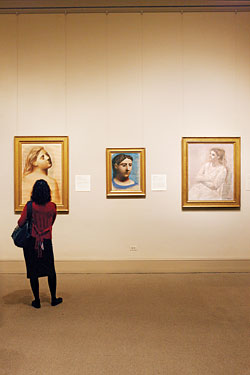
It took the Metropolitan Museum of Art nearly 50 years to wake up to Pablo Picasso. It didn’t own one of his paintings until 1946, when Gertrude Stein bequeathed that indomitable quasi-Cubistic picture of herself—a portrait of the writer as a sumo Buddha—to the Met, principally because she disliked the Museum of Modern Art. Yet even this didn’t provide the Met a shot in its curatorial arm. (As late as the fifties, Met director Francis Henry Taylor was still calling MoMA “that whorehouse on 53rd Street.”) Only in 1979, after hiring the curator William S. Lieberman away from MoMA, did it start its long game of catch-up. Today, after relying on the kindness of donors and spending untold millions, the Met owns more of his work than any American museum except MoMA.
“Picasso in the Metropolitan Museum of Art” includes 300 works—nearly all the Picassos it owns. Given the fitful way this collection was assembled, it’s not surprising that it provides an uneven view of the artist’s singular career. Certain bodies of work (notably the Blue- and Rose-period paintings; several fantastic works on paper from the early teens; a handful of stunning masterpieces from the thirties) are jaw-dropping. Other periods, like his Cubist years and the late decades of his life, are practically absent. Yet in its meandering way, the Met’s show keeps an important revisionist ball rolling. Along with two other stellar Picasso exhibitions currently running, it’s helping sweep away the ridiculous, pernicious conventional view that Picasso was mediocre before Cubism and washed up afterward—that after his one huge paradigm shift from about 1906 to 1914, he sputtered through a sad, 60-year end.
The first three galleries contain a generous group of formal and sexual shockers that instantly prove the first part of that theory wrong. From 1903, when he was 22, there’s the almost barbaric, unexpectedly graphic Erotic Scene, the painting that’s usually called La Douleur. We see Picasso lifting his head to watch us watch him being fellated by a long-haired, faceless woman. In this nearly pre-lingual thing, the female figure is nothing but gangrenous curves, an inhuman animalistic being bowed before the would-be silverback male. The Met curator Gary Tinterow maintains that the picture lacks “quality” and “erotic intensity,” but I don’t agree. La Douleur pulsates with primitive psychic power and visual originality, and shows an artist arriving simultaneously at carnal knowledge of himself and his art.
Next come some great pictures made between 1901 and 1906, the years known as the Blue and Rose periods. Scholars say these works are hard to understand, but it’s clear from the alternately luscious, moody, brooding pictures of willowy beings and melancholy harlequins that Picasso’s bounteous imagination is moving to the fore. Subject matter fades until you’re not sure what you’re seeing. These people look nowhere; they hold on to nothing and are barely breathing. An eerie painterly haze envelops the uncanny images. The Blue and Rose periods are about the neatness of pictorial identification disintegrating before your eyes, dimensional reality going wobbly, 1,000 years of Western figurative painting beginning to melt amid a challenge to conventions of depiction.
After those galleries, we’re poised to see the Cubist revolution. And then, of course, we don’t. Other than two great pictures—one the 1909–10 Woman in an Armchair, which shows Picasso shattering Cézanne’s portraiture, and Guitar and Clarinet on a Mantelpiece, a 1915 geometric arrangement that strips illusionistic space to its bare bones—Picasso’s towering breakthrough barely makes an impression.
But the next gallery saves the day, makes the show, and again proves Picasso skeptics wrong. In this densely installed room of work done mid-career—between 1918 and 1938—is The Dreamer, an otherworldly tour de désir of Picasso’s then-lover, Marie-Thérèse Walter, one of the most seductive, sensuous images of a woman ever painted. Picasso once said he could draw better than Raphael; The Dreamer makes you think he sometimes painted better, too. A beautiful lavender odalisque or shimmering squidlike creature sleeps naked, her head tilts back, blonde hair flowing, cheeks flush, oblivious, transported to another dimension. In a Boschian, Botticelli–by–way–of–De Sade sort of way, flowers sprout from her anus; her legs taper into an upturned bird-beak. This mythic chrysalis is lost in metaphysical metamorphosis. Nearby, in Man With a Lollipop, from 1938, a man who’s probably Picasso (who was then almost 60) appears as a crimson-colored demon in what looks like a wicker T-shirt, his mouth a vagina dentata. The artist is turning his relentless X-ray vision on himself, something he did more and more as he aged.
And finally, the very late Picasso, where once again the Met’s holdings are patchy. Based on what the Met owns, you’d be forgiven if you accused him of coasting. But the last gallery may change your mind. It contains 100 erotic etchings made in a burst of less than seven months in 1968, five years before Picasso died, at the age of 91. These, and two nearby late paintings, prove that Picasso retained his technical control, psychological insight, and hallucinatory intensity to the end. They are scintillating.
Turns out Picasso’s passion for uncertainty, mystery, and the thrill of life never ended. You almost don’t miss the Cubist years at all.

Video: Saltz on Picasso
Picasso in the Metropolitan Museum of Art
Through August 1.
E-mail: jerry_saltz@newyorkmag.com.